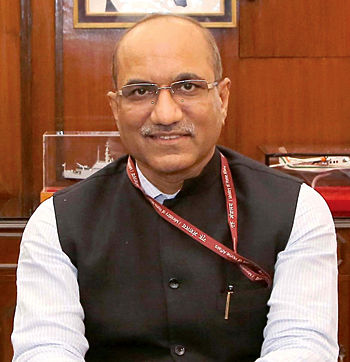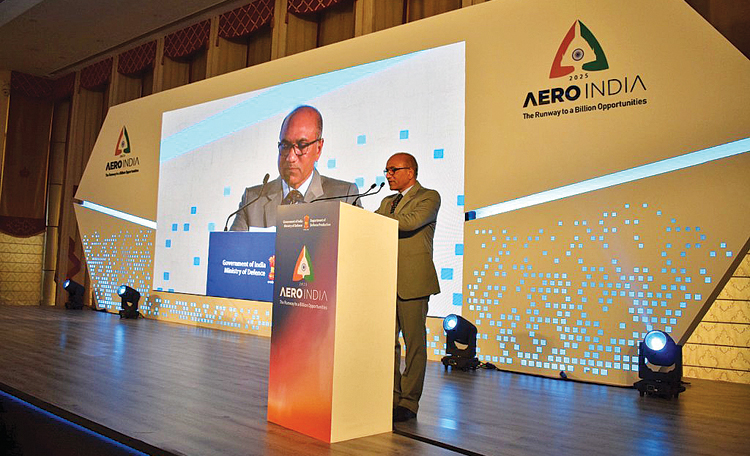INDIAN ARMED FORCES CHIEFS ON OUR RELENTLESS AND FOCUSED PUBLISHING EFFORTS

The insightful articles, inspiring narrations and analytical perspectives presented by the Editorial Team, establish an alluring connect with the reader. My compliments and best wishes to SP Guide Publications.

"Over the past 60 years, the growth of SP Guide Publications has mirrored the rising stature of Indian Navy. Its well-researched and informative magazines on Defence and Aerospace sector have served to shape an educated opinion of our military personnel, policy makers and the public alike. I wish SP's Publication team continued success, fair winds and following seas in all future endeavour!"

Since, its inception in 1964, SP Guide Publications has consistently demonstrated commitment to high-quality journalism in the aerospace and defence sectors, earning a well-deserved reputation as Asia's largest media house in this domain. I wish SP Guide Publications continued success in its pursuit of excellence.
- The layered Air Defence systems that worked superbly, the key element of Operation Sindoor
- Operation Sindoor | Day 2 DGMOs Briefing
- Operation Sindoor: Resolute yet Restrained
- India's Operation Sindoor Sends a Clear Message to Terror and the World – ‘ZERO TOLERANCE’
- Japan and India set forth a defence cooperation consultancy framework, talks on tank and jet engines
EXCLUSIVE
“Will Continue the Policy for Defence Reforms to Boost Manufacturing”
Furthering the country’s defence production target of ₹ three lakh crore by 2029 and leading such initiatives is Sanjeev Kumar, Secretary, Department of Defence Production, Ministry of Defence. In an exclusive interaction, Consulting and Contributing Editor Manish Kumar Jha speaks with the Secretary, on his roadmap and policies for spurring defence manufacturing in India, for both – public and private sectors.

A technocrat with Electronics & Communication Engineering from IIT, Kanpur, he is poised, and well-placed to understand the complexities of military technology and ever-changing dynamics of production in the wake of AI, ML and hybrid/autonomous modern assembly lines. Further, his leadership in designing and launching various national policies and initiatives including the PMAY is highly encouraging that he would be rallying for reforms and efficiency in India’s quest for self-reliance not only in the higher scale of defence manufacturing but put his thrust on new emerging and critical technologies.
In this special conversation, Sanjeev Kumar outlines the policies for defence competitiveness globally for Indian industry –private and public, thrust on advanced technology such as engine, propulsion systems and materials and what are the incentives or policy direction to excite R&D in defence industry?
Manish Kumar Jha (Manish Jha): India’s defence production reached a record high of approximately ₹1.27 lakh crore. The country’s defence production is aimed to reach a target of ₹ three lakh crore by 2029. Could you give the roadmap?
Sanjeev Kumar: The story of India’s Defence production in right earnest, started in the year 2014-15 with government focus on ‘Make in India’ and Atmanirbhar Bharat. The domestic defence production has grown from ₹43,746 crores in 2013-14 to more than ₹1,27,000 crores in 2023-24.
“Defence exports involve multiple stakeholders and importing countries prefer quality equipment trusted and used by our armed forces hence endorsement of our armed forces directly or indirectly plays a very critical role”
Clarion call given by the Prime Minister for Atmanirbhar Bharat got reflected in the policies of Defence Procurement by reserving 75 per cent of Capital procurement through domestic route under DAP-2020. Support, guidance and acceptance by Indian Armed forces and the response of Indian industries to the products developed by DRDO have resulted in the fruitful realisation of the Atmanirbhar policy.
Further announcement of Positive indigenisation list of more than 5,000 items, simplification of defence industry licenses, relaxation of FDI, launch of Innovations for Defence Excellence (iDEX) etc, strengthened the initiative for Atmanirbhar Bharat.


The establishment of two industrial corridors in Uttar Pradesh and Tamil Nadu is also helping the cause immensely. Focus on rationalisation of the process for export authorisation and liberalisation of the list of Defence articles available for export is also creating a viable export market for Indian Defence Industries. This developing and vibrant ecosystem is expected to take us to the target of three lakh crores in Defence production by FY 2028-29. Needless to say, our Ministry and Department will continue to fine-tune various policy instruments available at the hands of the Government to promote Indian defence industries.
Manish Jha: Could you talk about the contribution of the private sector in defence production now? Could you please talk about the new policy thrust to spur production?
Sanjeev Kumar: Private sector industries are also playing a very important role in the defence production sector. Our defence production sector was opened to the private sector in 2001 but a major push for the private sector in the Indian defence Industry came in the year 2019 when licensing was relaxed. In the year 2022-23, 25 per cent of funds kept for domestic capital acquisition were earmarked for acquisition from the private sector. In 2024, the Indian private sector has contributed almost ₹27,000 crores in the year 2023-24 in defence production as against ₹14,000 crores in the year 2016-17. Policy measures like streamlining the procurement process, and schemes like iDEX, and ADITI are ensuring a level playing field between the private and public sectors. DRDO is releasing technologies to the private sector. These factors have helped the growth of the private sector in Indian defence industries and their contribution is visible not only in their turnover but also in the number of equipment, systems and sub-systems which they are not now supplying to our armed forces and exporting to various countries. The private sector is very significantly contributing to the preparedness of all three services, that is, Army, Air Force and Navy by providing a wide spectrum of platforms or components used in various platforms. The private sector is spearheading our exports of defence products and their share is 62 per cent of total exports of ₹21,000 crores in the year 2023-24.
Manish Jha: While India’s defence exports reached a record high of ₹21,083 crore in 2023-24, what are the policy directions to boost it further amid the highly competitive global market? What are the steps to increase the international footprint?
Sanjeev Kumar: India’s Defence export has been a story of satisfaction for all of us. Prime Minister’s emphasis on ‘Make in India’ not only for India but also for the world, has played a motivating and catalytic role. Many policies and administrative measures have been taken in the last decade to increase exports manyfold. Push for indigenisation and resourcefulness of the private sector has played a major role. The contribution of the private sector to defence exports is much more significant. Simplification of export authorisation by the Department of Defence Production (DDP) and DGFT along with MHA has gone a long way in enabling exports. The entire authorisation process is online through a portal.

More and more products are allowed to be exported through open general export licenses. We are in the process of further simplifying and rationalising the SOP for export authorisation which shall happen this year in the “Year of Reform” as exhorted by the Defence Minister.
It is also to be noted that defence exports involve multiple stakeholders and importing countries prefer quality equipment trusted and used by our armed forces hence endorsement of our armed forces directly or indirectly plays a very critical role. Support of our armed forces has been commendable in this aspect.
India has the unique opportunity of manufacturing or maintaining the platforms/technologies of both Western and Russian origin. This gives us unique opportunity to export our products or services to the countries using both type of technologies.
Manish Jha: How does the public procurement process boost domestic production for both private and DPSUs?
Sanjeev Kumar: Major role in promoting Indian defence domestic production has been played by procurement process adopted in the DAP 2020. Now 75 per cent of the capital procurement by armed forces is through Indian defence industries.
Further processes like IDDM, Make-1, Make-II, iDEX and ADITI have promoted indigenous development of prototypes and products. Positive Indigenisation Lists of DPSUs and Armed forces have created large assured market for our MSMEs giving them opportunities to be a part of Indian Defence Industry and rise in the value change in coming years.
Manish Jha: Recent reforms of Ordnance factories into DPSUs aim to bring efficiency and higher innovations. Could you talk about their growth in terms of production and revenues?
Sanjeev Kumar: The Ordnance Factory Board was corporatised in the year 2021 and converted into seven new Defence Public Sector Undertakings consisting of 41 factories. Ordnance Factories were supplying equipment and ammunition mostly to the Indian Armed Forces and within a short span of three years since their Corporatisation, these new DPSUs are competing in the market and are being reasonably successful in getting supply orders from the Armed Forces. New DPSUs are also working on improving their delivery schedule. They are also focusing now on the development of new products & improving existing products.
“The government is encouraging R&D spend in defence by industries by encouraging procurement from domestic industries and operating various schemes for the design and development of new products, systems and sub-systems”
In terms of opportunities, the production of the new DPSUs in the year 2023-24 was ₹18,581 crores and their export is ₹1,977 crores it is clearly seen that their export has risen up significantly.
Manish Jha: Could you elaborate on the advanced technologies especially advanced materials, engine and propulsion systems for Indian defence?
Sanjeev Kumar: We have been focusing on the development of new defence technologies and products mainly through DRDO. Now industries, both in the private and public sectors, have also started giving attention to research and development. Gaps in our indigenous defence manufacturing capabilities are well recognised and efforts are being made to bridge those gaps. It is clear that advanced materials and engine propulsion systems are essential defence technologies. These technologies provide an edge to the countries that possess them in developing advanced weapon systems. It is not easy to get “transfer of such technologies” from other countries. The route for developing such technologies indigenously is long and arduous requiring patience and resources along with all-round efforts by all stakeholders including DRDO, other research and development organisations, academic institutions, industries and armed forces. All stakeholders are aware of the need and work has started in the field of many such technologies.
Manish Jha: R&D in production is the key. What are the incentives or policy direction to excite R&D in the defence industry?
Sanjeev Kumar: The government is encouraging R&D spend in defence by industries by encouraging procurement from domestic industries and operating various schemes for the design and development of new products, systems and sub-systems. Under the Make-1 scheme Government funding of up to 70 per cent is available for the design and development of defence equipment and system.
Make-II entails industry-funded R&D with government support in the form of guaranteed procurement. Under the iDEX Scheme, the Government has earmarked ₹498.78 crores, from 2021-22 to 2025-26, for providing financial support to Startups/MSMEs/individual Innovators for developing innovative technology/products. iDEX provides grants/funding up to ₹1.50 crore and other support to carry out R&D which has potential for future adoption for Indian Defence and Aerospace needs. Further, the ADITI (Acing Development of Innovative Technologies with iDEX) scheme with budgetary support of ₹750 crores was launched to provide support with grants of up to ₹25 crores, targeting the development of cutting-edge, critical and strategic technologies. Defence PSUs have also started investing more of their resources in the Design and Development of products and also R&D in niche technology. Private sectors are also increasing their R&D spending.





